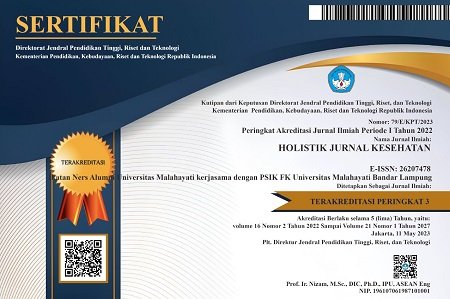INSPIRASI MUSCLE TRAINING (IMT) TERHADAP NILAI SATURASI OKSIGEN (SPO2) PADA KLIEN DENGAN GAGAL JANTUNG KONGESTIF
Abstract
Pendahuluan: Gagal jantung kongestif dapat menurunkan produktivitas bahkan dapat menyebabkan kematian. Angka kekambuhan setelah rawat inap sering terjadi akibat pola aktivitas yang tidak terkontrol dan gaya hidup yang kurang baik. Gagal jantung dapat mempengaruhi nilai saturasi oksigen, hal ini berkaitan dengan rehabilitasi pasien baik selama rawat inap maupun post hospitalisasi. Penatalaksanaan pasien gagal jantung yaitu dengan rehabilitasi sebagai upaya menstabilkan haemodinamik. penatalaksanaan diantaranya latihan pernapasan sebagai bentuk rehabilitasi non farmakologi untuk meningkatkan derajat kesehatan. Tujuan penelitian ini yaitu untuk mengetahu pengaruh inspiration muscle training terhadap nilai saturasi oksigen (SpO2) pada pasien gagal jantung kongestif.
Metode: kuantitatif dengan desain quasi eksperiment dengan pre-post test. Metode pengambilan sampel yaitu concecutive sampling, sampel dalam penelitian ini yaitu 15 orang kelompok intervensi dan 15 orang kelompok kontrol dengan total sampel 30 responden pasien gagal jantung di RSUD dr Slamet Garut. Analisa data dengan menggunakan uji Paired Sample Test.
Hasil: menunjukan adanya pengaruh signifikan setelah dilakukan intervensi latihan otot diafragma (p=0,000) dengan kelompok kontrol (p=0,614). Inspiration Muscle Training dapat meningkatkan nilai saturasi oksigen (SpO2) pada pasien gagal jantung kongestif dan merupakan latihan pernapasan yang efektif untuk membantu menstabilkan sirkulasi oksigen.
Keywords
Full Text:
PDFReferences
Adabag, A. S., Luepker, R. V., Roger, V. L., & Gersh, B. J. (2010). Sudden cardiac death: epidemiology and risk factors. Nature Reviews Cardiology, 7(4), 216.
Ades, P. A., Keteyian, S. J., Balady, G. J., Houston-Miller, N., Kitzman, D. W., Mancini, D. M., & Rich, M. W. (2013). Cardiac rehabilitation exercise and self-care for chronic heart failure. JACC: Heart failure, 1(6), 540-547.
Alves, J. P., Nunes, R. B., Stefani, G. P., & Dal Lago, P. (2014). Resistance training improves hemodynamic function, collagen deposition and inflammatory profiles: experimental model of heart failure. PloS one, 9(10), e110317.
Balitbang Kemenkes, R. I. (2013). Riset kesehatan dasar; RISKESDAS. Jakarta: Balitbang Kemenkes RI.
Bilo, G., Revera, M., Bussotti, M., Bonacina, D., Styczkiewicz, K., Caldara, G., ... & Kawecka-Jaszcz, K. (2012). Effects of slow deep breathing at high altitude on oxygen saturation, pulmonary and systemic hemodynamics. PloS one, 7(11), e49074
Brunner, L. S. (2010). Brunner & Suddarth's textbook of medical-surgical nursing (Vol. 1). Lippincott Williams & Wilkins.
Cahalin, L. P., LaPier, T. K., & Shaw, D. K. (2011). Sternal precautions: is it time for change? Precautions versus restrictions–a review of literature and recommendations for revision. Cardiopulmonary physical therapy journal, 22(1), 5.
Chiappa, G. R., Roseguini, B. T., Vieira, P. J., Alves, C. N., Tavares, A., Winkelmann, E. R., ... & Ribeiro, J. P. (2008). Inspiratory muscle training improves blood flow to resting and exercising limbs in patients with chronic heart failure. Journal of the American College of Cardiology, 51(17), 1663-1671.
Davies, E. J., Moxham, T., Rees, K., Singh, S., Coats, A. J., Ebrahim, S., ... & Taylor, R. S. (2010). Exercise based rehabilitation for heart failure. The Cochrane Library.
German, R. R., Lee, L. M., Horan, J., Milstein, R., Pertowski, C., & Waller, M. (2001). Updated guidelines for evaluating public health surveillance systems. MMWR Recomm Rep, 50(1-35).
Indonesia, P. D. S. K. (2015). Pedoman Tata Laksana Gagal Jantung. National Cardiovascular Center Harapan Kita Hospital.
Levenson, J. W., McCarthy, E. P., Lynn, J., Davis, R. B., & Phillips, R. S. (2000). The last six months of life for patients with congestive heart failure. Journal of the American Geriatrics Society, 48(S1).
Penelitian, B., & Kesehatan, P. (2013). Riskesdas 2013. Jakarta: Badan Penelitian dan Pengembangan Kesehatan Kementerian Kesehatan RI, 1.
Pollentier, B., Irons, S. L., Benedetto, C. M., DiBenedetto, A. M., Loton, D., Seyler, R. D., ... & Newton, R. A. (2010). Examination of the six minute walk test to determine functional capacity in people with chronic heart failure: a systematic review. Cardiopulmonary physical therapy journal, 21(1), 13.
Snoek, J. A., Van Berkel, S., Van Meeteren, N., Backx, F. J., & Daanen, H. A. (2013). Effect of aerobic training on heart rate recovery in patients with established heart disease; a systematic review. PloS one, 8(12), e83907.
Swank, A. M., Funk, D. C., Manire, J. T., Allard, A. L., & Denny, D. M. (2010). Effect of resistance training and aerobic conditioning on muscular strength and submaximal fitness for individuals with chronic heart failure: influence of age and gender. The Journal of Strength & Conditioning Research, 24(5), 1298-1305.
Weakness, I. M. (2006). Inspiratory Muscle Training in Patients With Heart Failure and Inspiratory Muscle Weakness. training, 757, 63.
Yeh, G. Y., McCarthy, E. P., Wayne, P. M., Stevenson, L. W., Wood, M. J., Forman, D., ... & Phillips, R. S. (2011). Tai chi exercise in patients with chronic heart failure: a randomized clinical trial. Archives of internal medicine, 171(8), 750-757.
DOI: https://doi.org/10.33024/hjk.v12i1.136
Refbacks
- There are currently no refbacks.
Copyright (c) 2018 HOLISTIK JURNAL KESEHATAN

This work is licensed under a Creative Commons Attribution-NonCommercial 4.0 International License.














